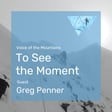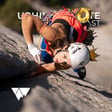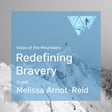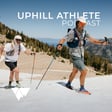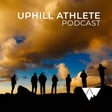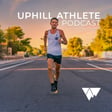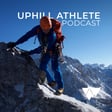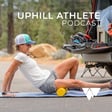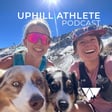Become a Creator today!Start creating today - Share your story with the world!
Start for free
00:00:00
00:00:01

Trail Running Series: Strength Training
Steve and Alyssa welcome back Coach Alexa Hasman to discuss the specifics of strength training for trail runners. They break down why trail runners should prioritize strength training and its benefits for injury prevention, climbing speed and descent durability among many others. The three discuss how to periodize strength training to fit a racing schedule as well as tapering principles and accommodating for B and C level races. Lastly, Alexa shares her top strength exercises for runners and how to fit them into a busy lifestyle. Strength training is crucial to success for mountain runners and Uphill is here to help you prepare and be your best.
Transcript
Introduction and Guest Background
00:00:00
Speaker
Welcome to the uphill athlete podcast. Our mission is to elevate and inspire all mountain athletes through education and celebration. My name is Steve Housen. I will be your host today, along with Alyssa Clark. We're joined by a previous guest, our esteemed coach and coworker, Alexa Hasman.
00:00:27
Speaker
returns to the podcast today to discuss strength training for trail runners. Alexa is the lead coach of our trail running training group and has an extensive background in both ultra running and a focus in strength work and her educational academic background.
Importance of Strength Training
00:00:44
Speaker
Alexa, thank you for being on the podcast. Hey, thanks for having me.
00:00:50
Speaker
we're stoked to have you on again. And the last time we touched on mental training quite a bit with you, you're a woman of many hats. But this time, you also have an extensive background in ultra running and strength training. I think those are two of your kind of main focuses, right? Yeah, I must well super passionate about strength training as a supplement to my first passion, which is ultra running. So yes, I love both.
00:01:21
Speaker
So how did you decide to focus on strength training? Like what led you to that, seeing that as a super important aspect of training for ultra running and also just being a really good mountain athlete? Yeah, I think what was the main catalyst for it was knowing that a lot of the races I wanted to do went up massive climbs.
00:01:47
Speaker
And to get up massive climbs, you have to be massively strong, right? So that was the first aspect. And then dealing with injuries and noticing that I was a lot stronger and less injury prone when I was strength training was really important.
Why Strength Train for Trail Running?
00:02:05
Speaker
I dealt with a lot of ankle sprains. Because of that, I was dealing with a lot of tendinopathy and sort of just imbalances in my body. And so strength training became sort of integral in
00:02:17
Speaker
helping me rehabilitate and come back from those injuries and come back stronger and healthier and sort of prevent that going forward in my running. So to summarize that.
00:02:31
Speaker
What are the important points for trail runners listening to this? You know, I get, and I think that we can all agree that strength training is not super popular in the culture of trail running and mountain running. So, you know, if you're selling a trail runner on the value of strength training, I think you've kind of just summarized some of those points, but what would be your elevator pitch for why a trail runner should strength train? Yeah, good question. Do you want to be efficient in getting through your ultra? Do you want to be,
00:03:01
Speaker
finishing strong and feeling good, do you want to be preventing injuries? There's so many ways to sort of sell strength training and it's hard because yeah, in this field, strength training is often talked about as a negative or it's sort of like, oh, you don't need to do that.
00:03:19
Speaker
Um, I think people get worried about being bulky. I think people worry about the time commitment because it's true ultra running training for that includes a lot of time. Uh, and strength training is just on top of that, but the importance of it is astronomical. So why train for an ultra and put in all those hours of running and then put yourself at risk of injury when you can add just a little bit of strength training and help prevent that.
Handling Descents and Muscle Soreness
00:03:44
Speaker
So.
00:03:46
Speaker
I would also add on to those answers, and you honestly gave us the best elevator pitch for this whole entire episode right there, is that it's crucial for the latter parts of the race when you're starting to deteriorate. It's your strength and that power that will get you through the challenging ascents and descents.
00:04:11
Speaker
especially I think strength is so key oftentimes if we're racing in the Alps if we're racing in the mountains we have these massive descents to get back into town to get to the finish and if you have blown your quads out if you're really feeling the delayed onset muscle soreness that's something that you're gonna end up walking walking it in I think we've all experienced what that feels like and strength training is so key to
00:04:39
Speaker
delaying that response, as well as just if you live in a flatter area and you want to tackle these big mountain races, if you love doing that, strength training is so key to being able to be successful. It's kind of our quote unquote secret weapon to living in flat areas is being able to strength train and be successful when you when you step out into those mountains.
Phases of Strength Training
00:05:06
Speaker
So Alexa, when you're designing a plan for trail runners, what does your prescription of strength look like for the week? And how do you periodize your strength training for a trail runner? Yeah, good question. So I think it really depends on the athlete and their history with strength training. That's going to be the first thing that I look at, but remains the same is the periodization. So we're always going to start with.
00:05:35
Speaker
like a max phase. And by max phase, I don't mean like one rep max. I mean like you're doing max strength phase. So you're working on the muscular strength aspect of training. And we're going to do that for like, depending on the amount of time that you're training, four to six weeks, and then we're going to move into muscular endurance. And again, this is really based off of the amount of time that the athlete has to train for their event. Muscular endurance, we're working on the longevity of the muscle contraction. How can they hold that?
00:06:05
Speaker
when going down a hill, up a hill, that repetitive movement. And that is going to be another four to six weeks after that max strength phase. And then after that two to three weeks before the event, we're really focusing on the maintenance phase of strength. So we're working on maintaining core strength and glute strength and shoulder strength, which is I think often overlooked.
00:06:28
Speaker
And so, yeah, I think those are the three main phases that we go through. Now on a weekly basis, again, that depends on the athlete, how much time they have, their history of training, but ideally what I like to see is two to three specific sessions focused on strength.
00:06:49
Speaker
And then ideally, if they can, adding in little strength things throughout the day just to sort of add to that. So whether that is doing single leg stands while they are watching TV or cooking dinner or anything like that, just adding in little things that they can do throughout the day so that strength training doesn't become this burden on their life, but it's more of like just an addition.
00:07:17
Speaker
Yeah, and this follows right along with, you know, everything we've laid out in the training for the new albedoism and training for the epilathlete books. You know, we will also talk about the general conditioning or general strength phase at the beginning to kind of get people ready for training, the max strength.
00:07:36
Speaker
And students of the books will recognize that those phases, the max strength phase can be extended. You know, typically around eight weeks is where we see things start to fall off in terms of gains. And then the muscular endurance phase, of course, is like a lot of fun and everybody loves it. And it's one of our most trainable qualities. We've talked a lot about that on the podcast and other places, but also a lot in the books. So, and the maintenance, I think those are all
00:08:06
Speaker
great places to kind of dig into.
Periodizing Training for Multiple Races
00:08:10
Speaker
So let's just take it one by one, Alexa. How do you talk about max strength? Do you have favorite exercises for trail runners? I think we're all kind of aligned. Maybe start off by sort of aligning people on what that feels like. What is a max strength workout itself actually feel like to an athlete when they go into the gym?
00:08:35
Speaker
think about max strength, I think it comes off as a really intimidating term. We think of one rep max, like what can I squat? What's the heaviest I can squat? What's the heaviest I can deadlift? And when we specifically at uphill athlete are talking about this max strength phase, what we mean is four to six reps of heavy weight. And that means the feeling that you should get is I could do a couple more reps of this, but I would really rather put the weight down right now.
00:09:04
Speaker
And so you're doing four to six reps and you're doing four to five sets of those reps. The biggest key to this max strength phase is the rest that you do between those sets. And that's going to be a long rest period. And we're talking like
00:09:20
Speaker
three, five minutes. This is what I think is the ideal time to look at ultra sign up, scroll through the races you're interested in, really get yourself amped up and then go back to squat. So yeah, that's what that max strength phase looks like. And this is the really important part for that power and that push off and that really explosive, strong ability that ultra runners have. That's where this max strength phase comes in.
00:09:50
Speaker
Yeah, and I think I would add there's just a big neurological component and people need to remember that there is a lot of training effect here that is purely neurological. And this is the reason we use this for athletes where they have to carry the engine, so to speak. We have to carry the muscles around. We're not bodybuilders. We don't want to be big. We don't want to be heavy. But we do want the muscles we have to be able to
00:10:20
Speaker
you know, fire together and generate a lot of force so we can be fast and strong on the uphills and resilient on the downhill. So I think that that's a really important way that I try to communicate with my athletes how to think about it.
00:10:36
Speaker
Yeah, absolutely. I think we've all been in that situation where we've seen those downhills and there's runners on the sides of the trails and their quads are blown up. And how can we avoid that? Because we all want to avoid that. And that's where max strength comes in. So it's not just giving up the amount. It's not just going down. It's also flat running, everything. And like I said, the injury prevention part of it.
00:11:03
Speaker
So why that long rest? We had a great question yesterday. We were doing a training group and someone asked, what is the actual physiological reason for needing that long rest versus us who are constantly like, oh yeah, the more we do, the more we can cram in in a short amount of time, the better. Like, why do we need that rest? What's happening in the body?
00:11:25
Speaker
That's a really good question. The amount of rest is really so that you can get the most muscle recruitment in your next set, right? So it's sort of like interval training. You want to rest as much as possible so that you can have the best next interval in your running that you can.
00:11:44
Speaker
So you don't want to go into this set or rep tired. That's the muscular endurance phase. We're not in that phase right now. We're in the I want to be strong phase. So this is the time to rest and really make sure that you're able to recruit as many muscle fibers as you can.
00:12:01
Speaker
because you're teaching your neurology to recruit as many muscle fibers as you can. And if you're a little fatigued and the muscles themselves aren't recharged with, with nutrients and having, you know, flushed out their waste products, they won't be able to actually, you know, fully contract too. So that's a great point. Alex, I just wanted to follow up on that. Yeah, absolutely.
00:12:26
Speaker
Awesome. So after we have max strength, we're going into muscular endurance and I'm not going to, we're not going to get too far into muscular endurance on this episode because we actually have an entire episode dedicated to talking about muscular endurance. Um, but I guess just really briefly, what is muscular endurance? Um, and how long would you recommend a trail runner, um, stay in this phase?
00:12:57
Speaker
Yeah, so muscular endurance is really important for ultra runners and trail runners because well, we're endurance athletes, right? So we want that longevity of strength and power. So when we're working on the muscular endurance phase, this is eight plus reps and we are really working on that like burn factor. Like you know that feeling that like
00:13:21
Speaker
that aching, burning feeling that you get when you're doing a muscular endurance workout. That's the goal of it. That heavy legs, the hard to push through.
00:13:33
Speaker
The limiting factor is the legs aspect of the training. I can breathe all day, but I cannot move faster because my legs are just killing me. My muscles are giving up. That's where muscular endurance is coming in.
00:13:52
Speaker
So that's super important because a lot of what we do, and this is something again we're going to talk about a little bit later, is that I think we often consider trail running and you can get really light with trail running. I mean I've seen Jim Wamsley
00:14:08
Speaker
I haven't seen him specifically, but seen pictures of him running with just a handheld for shorter races that have a lot of aid stations. But if you start getting into longer races, more required equipment, you're not running scot-free. You're running with quite a bit of weight on your back with you. And so being strong through this, being able to carry weight is super important to training.
00:14:35
Speaker
Yeah, and I think that's something I'm really experiencing right now, especially training for the 200 is that the aid stations are so far apart that you have to carry a significant amount of hydration and food and all the required gear. And it is a lot and it adds up really quickly. So it is really practicing being able to, that's why I say like, we often overlook shoulders, but shoulders are really important. And also when you're using poles, shoulders are really important.
00:15:05
Speaker
Completely. Lifting those poles up. I always remember when I would start my summer guiding season and I would just lifting the ice axe up 3,000 times. Just simply walking uphill, lifting up. It's amazing how specifically we get conditioned to certain movements. Train those before you actually get to the race, for sure.
00:15:30
Speaker
totally. And we're also just even if we're not using poles, we're using our arms to propel us forward. And so I think a lot of trail runners will be like, well, I'll just do my lunges or I'll just do squats or deadlifts. You got to really think about your shoulders, but also your core. Like I know that specifically I am always the sorest in my abdomen after races.
00:15:52
Speaker
same. I like to think of it as I'm just laughing away down the course. But it's truly I mean, gosh, I think the worst case of it was finishing Moab. My core was so sore. From just as with a pack, I mean, you're wearing that pack for upwards of
00:16:15
Speaker
70 80 90 100 hours and that is just a lot of strength and especially as you're climbing mountains and you're pulling your leg up, you know things are the more Strength you have the more kind of defense lines you have along the way to keep you moving forward if you shoot yourself like you you use kind of your
00:16:41
Speaker
your major muscles, you start weakening because we all do. The more you can continue to rely on as many muscles and as much recruitment as possible, the more you'll be able to keep pushing forward.
Balancing Competitiveness and Enjoyment in Races
00:16:57
Speaker
Absolutely. And remember that core keeps you stable. It keeps you upright. That's the whole point of your core is to keep you balanced and moving. So that's sort of an important aspect of being upright in trail running. Yeah. You had mentioned, you know, we talked about general strength, max strength, muscular endurance. We talked briefly about, you know, strength training during the specific phase.
00:17:25
Speaker
But let's go back a little bit and go back into max strength. Like how many times can an athlete do a max strength?
00:17:36
Speaker
period in say a year, or what does that look like? And so a lot of runners, they're training for multiple events. Maybe they have a big A race in May. Maybe they've got another A race in, I don't know, September. That's not an uncommon layout. There's probably some B and C races along the way. I think it's really important to think about the distribution of these periods and in your planning.
00:18:03
Speaker
How do you, what framework do you have for people to think about that?
00:18:08
Speaker
Yeah, so how I look at it as a coach is I always start with the A race and I plan backwards from there. Now, a lot of us have multiple A races throughout the year. And I always suggest not having more than three. Three would be on the high end. But let's say the average trail runner has two to three A races per year. So you're going to build backwards from that. So after the first A race, you want a recovery time. You want that rebuild, check-in.
00:18:36
Speaker
phase of things where you're checking to see where there's imbalances, where there may be some injury potential, where can we work on getting all situated before we move into that max strength phase. And then you move into that max strength phase. And let's say you have plenty of time leading into your second A race.
00:18:54
Speaker
then let's aim for six to eight weeks. Let's get the most out of that time before moving into that muscular endurance. And same thing. So you're working backwards from the A race, you're taking two to three weeks from maintenance, you're doing four to six weeks for muscular endurance, you're doing, you know, upwards of eight weeks of max strength. And before that, you're really working on like checking in with your body and seeing where you need to focus and what might need to be addressed before moving into those phases.
00:19:21
Speaker
Alexa brings up a great point we've also heard it from John Kelly in that podcast that it can be extremely exciting and people can get too focused on racing too often and really getting the sense of FOMO of like oh my gosh I want to do that race I want to do that race and truly you can only have
00:19:47
Speaker
between one to three really a goals, um, because you have to train to get better, to see improvement. And if you're racing too much, you're preventing yourself from actually treating cause you're always, even if they aren't per se a races, you're always build air like tapering and then recovering. And so you're spending all of your time, um, in,
00:20:12
Speaker
these kind of transitional phases rather than putting in really solid training phases and I think that's one of the especially with younger runners or we'll call them over enthusiastic runners who are like I just want to do all the races and then they get really um defeated because they're not seeing improvement it's like well actually you need to to brace less to then see that improvement um and I'm sure Steve
00:20:41
Speaker
you can probably attest to that in the climbing world. How many big expeditions and goals did you have per year? Yeah, I mean, I would have basically one big expedition a year. And in reality, I would have one A trip and then two B trips, and I would try to get one thing done a year. That was a good year.
00:21:05
Speaker
doing one good thing. And I think that I've seen that a lot as a coach too, Elisa, where people start off with training and they're doing exactly what you described. And I think there's probably a lot of people listening who are like, oh, that's me. I actually do that because a lot of people do and it's totally normal. And that's more or less the shift in the culture that we're trying to help people understand the value of
00:21:33
Speaker
in all of these mountain sports. You can just race yourself to shape or climb yourself to shape to a point, but then you just kind of hit that level that's going to be your level and you're never really going to progress beyond that, which can be fine if you're just there to finish, but where I think that it comes up short a little bit is that people actually get bored.
00:21:59
Speaker
with the racing because when they're not seeing improvements because ultimately these sports are more of a personal journey than a competitive journey and you want to feel like you're learning, growing, progressing and if you're stagnating and not doing longer races or similar races but in faster times and that kind of thing you're going to lose interest and I think that that's to everyone's detriment.
00:22:27
Speaker
Yeah, absolutely. And I think, you know, I can relate to that too. Like there's so many fun races, it's hard to be like, oh, I only want to focus on one thing. So I think what a good plan for that is having those BNC goals, you know, like having some fun races that aren't
00:22:46
Speaker
the big focus of your year and saying like, I'm going to do these casually and I'm going to have fun with this. And that's a really good way to combat that sort of FOMO feeling and still focus on your A goals. So with that, what does that look like for strength training when you are working in these BNC races? How do you
00:23:12
Speaker
Alexa, if your client comes in and says or even yourself says, Hey, I'm gonna do instead of this training run, I'm gonna do a 50k race this weekend. How do you structure their training around that racing?
00:23:26
Speaker
Yeah, that's a good question. And I think of it like myself. That's literally what I'm doing currently, is I'm just jumping into a bunch of local trail races just for casual assisted long runs. I think it's fun. I like being with the community. But I'm not racing them, right? And so I don't change my strength training. Nothing about that changes. So whatever phase I'm in is the phase that I'm, or is what I'm going to be doing leading into that race.
00:23:50
Speaker
Another reason behind that is because I want to be able to train on tired legs. That's the goal of trail running. Your legs are getting tired at some point. I want that feeling of fatigue when I go into these B and C races. I'm not trying to be fresh. I'm not trying to be tapered. I'm not changing anything about my strength training. Now, that does mean there are
00:24:15
Speaker
I do avoid where I put them in the weekly schedule. So I'm not going to do a hard leg the day before the race. I might put it a few days earlier. But other than that, I'm not taking away any of those strength training activities that I'm doing. Awesome. Yeah, and the other thing that I would add as a caveat to using BNC
00:24:40
Speaker
races as training is to know yourself. So Alexa is awesome at being like, I can run a 50k at a very conservative pace because I know it's training.
00:24:54
Speaker
I know myself and I know that I am really bad at being able to literally even a 5k, I'll be like, I'm just going to do this in jean shorts and then all of a sudden I'm running as fast as I can in jean shorts. So if you are someone like me who can't dial it back because you get into competition and you're like, I'm competitive, I must go, then you have to realize that maybe racing actually isn't the best way to
00:25:23
Speaker
train and so you have to be really honest with yourself of what your level of self-control is because it's kind of like if you if you want to eat the whole cake probably don't put the whole cake in front of you if you're good with just a slice awesome then leave the cake out you know you have to understand your personality for me I know that using races I can use them
00:25:53
Speaker
with the idea that like, yeah, I'm probably going to go pretty hard in this race. And that's okay. And I don't have to be rested for it. But I'm also not going to say, Hey, I think it's a good idea to jump in this 50k. And I'm gonna try to go slower. That's just not really how my mind works. And so I think it's very important to be honest with yourself of what does my mind do when I get in a race? Is it okay for my training? Or is it actually act as a detriment? And I should just go out and do my own thing.
00:26:24
Speaker
Yeah, absolutely. I think that's such a valid point and there are so many of us that are uber competitive and I totally get that. I was very much the same way and it's taken a ton of mental training to be like, and that's why I have to put up checkpoints in my casual, as I call them, casual 50Ks or casual B or C races. I have to put in like, I specifically cannot
00:26:50
Speaker
chase down anybody. I specifically have to do these things at aid stations. And so I put in these checkpoints to make sure that I am not being competitive because I'm the same way. You get that hunter mentality. You see a runner in front of you and you're just locked in. And to break away from that, you just got to be like, nope, head down. This is training. And it is so hard. It takes so much practice.
00:27:18
Speaker
I think you had some great, because I know you just did a 50k the other weekend, and I remember you saying your goals and it was like dance with aid station members say as high to as many of them as I can. You ended up tacking on some bonus miles at the start, somewhat by accident, but I think just having those goals
00:27:43
Speaker
rather than finish goals are so key and also just really being focused on what's the bigger picture. What am I really aiming for? That will help with some of that self-control. But I love hearing, well I guess what, I heard the aid station one, but what were some of the things that you were aiming for in that race over placement?
00:28:04
Speaker
Yeah, so there's a few things that I tried. Well, I think it really helped that I got lost before the first aid station. So I had already put myself at a bit of a detriment with being a couple miles off course. But yeah, I try to stand there and talk to the aid station people and check in with them and sort of just have a conversation with them. And then I try to find people along the course to run with and sort of, I often go into this coach mode because you end up running with a lot of people that's like, oh, this is my first trail race.
00:28:33
Speaker
And sort of just sitting back and running with them and learning about them and talking to them. And it's great for me. I don't know if it's great for them, because I'm like, Hi, tell me about yourself. Tell me your life story. And they're all like probably trying to focus on breathing. But those are some of my big goals. And then
00:28:52
Speaker
I do not allow myself to hunt down runners. I cannot do that when I'm doing those races. Those are the main things. Make as many friends as possible. Learn about as many people as I can.
Effective Strength Exercises
00:29:08
Speaker
Talk to as many aid station people as I can. Check in with every runner that you see on the side of the trail. All those things. Those seem like generally good things to do in life anyway.
00:29:22
Speaker
They are. Make as many friends as you can. Back in with people that look like they're not doing too well. Sounds like a lot of crossover here. Yeah, just be a good human. Be a good human. Thank the volunteers. Yeah. Yeah. Yeah. So I know that people are going to expect us to answer this question. So what are the exercises?
00:29:46
Speaker
Yeah, okay, so my favorite exercise is, so when we're thinking about trail running, the biggest thing I try to reiterate with everybody is we are constantly in a single leg position and we're on uneven terrain. So when we're strength training, we wanna put ourselves in a single leg position and ideally in sort of an unbalanced position, right? So we start with like a single leg deadlift, a single leg squat,
00:30:15
Speaker
Now, if you have the experience and you have the training, add a balance board to that. Those sorts of things, step ups, step downs, really important, declined squats. Then we go to core and we want to focus on, I really like my favorite thing is the bear hold. And that's also known as like a quadruped hold or bear walks. I really like that. And that also is really good for the shoulders.
00:30:44
Speaker
So there's that, then there's single leg standing with shoulder press. So there you're working on balance, stability, and shoulder work, which is really nice. It's like a very good combo, a dynamic movement, or you could do a single leg deadlift to a shoulder press. So I could go on and on about all of my favorite strength training exercises. Yeah, those are all great ones. And I just want to highlight, you know,
00:31:09
Speaker
for people who have not done these movements before, aren't familiar with them before you jump on YouTube, just make sure you can do a really good deadlift. That's a great place to start for a lot of people because you get that posterior chain, you get some strength, it's safe, it's not intimidating because you can always just drop the bar or something like that that is
00:31:31
Speaker
is really a good place to start. Another place that's good to start in the book as well is a goblet squat where you're holding a weight in front of your chest. Again, it's not single-legged, but it's a great place to start out if you're not comfortable with these things. Because doing a pistol squat or even a thing like deadlift can be challenging for people.
00:31:53
Speaker
Or, you know, the other thing you can do is do it in your high volume or what do you call that? The high cushion shoes and your foot's already squishing around. That makes it harder. It's way easier to do those barefoot.
00:32:05
Speaker
Yeah, absolutely. I still can't do a pistol squat. So in addition to like glute bridges and those sorts of things where you're on the ground, but you can add some instability and you can add some weight, you can add some variance. You can also do that with bird dogs. And I think bird dogs is sort of an essential core balance stability move that you can add in, right? You're on all fours, but you're lifting up opposite leg and opposite hand. So you're automatically putting yourself in sort of an unstable position and your core is being forced to
00:32:35
Speaker
learn how to stabilize yourself, right? And in that, you're using your posterior chain to lift up that leg, you're using your shoulders. So that's a really great overall exercise. And it's really good for somebody that, well, I like to do it before all my workouts just to get things fired up. But also, if you're new to string training, this is a really good entry-level move that really is
00:32:57
Speaker
foolproof in that it's hard to get injured from doing a bird dog. You know, you're not you're not putting yourself in sort of a compromising position, like you could be with like doing like kettlebell swings or something like that, where you could actually really hurt yourself. So I think bird dogs is a really good option for most people.
00:33:14
Speaker
Yeah, I think that that makes a lot of sense. I think the other scary part about lifting for a lot of people, especially if you don't come from a strength background, is that some of the movements are scary and can feel a little bit dangerous. You know, you have
00:33:31
Speaker
um a bar across your back you're doing these bigger step-ups things like that can be really intimidating so i think exercises like the glute bridge like the bird dog you know those are things you can do around your house and they feel a lot less intimidating than per se walking in a gym being like am i gonna drop this weight on my toe um i've certainly been involved and seen some
00:33:56
Speaker
Strength training fiasco's and it is it is scary when there's a lot of weight being moved around. Oh Yeah, absolutely. You can definitely You can definitely open yourself up to some bad possibilities. So it's important that you either know what you're doing when you're playing with heavy weight or you have somebody there that's helping you that knows what they're doing and That's essential
00:34:20
Speaker
And people are really friendly in the gym, you know, they want to help you out. So it's always good to ask for help if you need a spot or whatever. But I also think that there's a lot of movements and exercises. And we talk about mostly these types of movements and exercises in the books and on the website that are very safe. Like it's really easy to dump the weight forward or something like that. And, you know,
00:34:47
Speaker
One of the things that we haven't mentioned that I want to kind of hit on because I think it may be is one of these points that is so obvious, it's easy to overlook, is that it's really important to track your weight and write down what you're doing and to make sure you're progressing.
00:35:05
Speaker
My rule of thumb with my athletes when I'm coaching is they get to do the same workout two times and if they're not, they have to increase the weight in the third session with the same movement. So to do that, you have to know that you did that movement with a 17.5 pound dumbbell because you're not going to remember it next week.
00:35:27
Speaker
If you're not able to progress, then you need to look at what that is. We're talking about max strength primarily, so we're not going to be talking about 17 pounds. We're going to be talking about, I don't know, 145 pounds or 135 pounds, some of these kinds of weights. You really need to pay attention to what you're doing in terms of what the actual weight is and make sure you're progressing. Yeah, absolutely. I think that is a really important factor for that max strength period.
00:35:57
Speaker
And that's a really easy thing to keep track of, whether it's notes and training peaks or even just notes on your phone, just as soon as you do it, write it down and then you won't forget
Eccentric Exercises and Final Training Phase
00:36:08
Speaker
it. Otherwise, I think we all know that every good intention of remembering things goes out the window as soon as life comes back to you right after the gym. Yeah. And that's a good thing to do in that rest period. You know, you don't know what to do in that few minutes of rest. Hey, write it down, write what you're doing.
00:36:28
Speaker
Yeah. And it's really, it's really motivating to look back the last few weeks and notice like how much stronger you've become. Yeah, definitely. Yeah. So one last question from me, I just wanted to do to talk about how to train strength training for the downhills. Yeah. Strength training for the downhills is my favorite. I love having the strength and power to blow past everybody on the downhills.
00:36:55
Speaker
And the big part of training for a downhill is eccentric strength. So that means having your muscle in an elongated state, because when you're going downhill, you're in a single leg position as always, but your muscle is elongated. So meaning like you're in that lowered squat position and it's contracting at the same time. So we want to mimic that exact same thing when we are doing our strength training to prepare for downhills.
00:37:25
Speaker
So that means we're doing eccentric squats and that means we're slowly lowering our body with that weight and then we're powering in that up movement. We're slowly lowering in that deadlift and then we're powering up through that pull up, right? So those are really good ones. And then putting your leg in that eccentric position,
00:37:49
Speaker
while holding it there. So a wall sit. I love wall sits. They're just such a powerful tool that we can do really anywhere. And you're putting that leg in that bent eccentric position. You're holding that that position. And also you can see a lot of change happen when you start incorporating more wall sits. I've had a client that really struggled with like downhill running because his knees always hurt.
00:38:17
Speaker
we started incorporating wall sits and he was terrible at them, could like barely hold them for like five seconds, right? And across time we've been able to increase that significantly, absolutely significantly. And in the meantime, that pain in his knees is gone and he can run down, down hills way more efficiently and effectively. And it's really alarming that like just wall sits can do something so amazing like that.
00:38:47
Speaker
I think that's awesome that you saw so much progress just with that exercise. You can do that anywhere. You can get into competitions with your kids. That's such a great way to incorporate something that has a huge impact. Yeah, and you can elevate it. You can add weight to it. You can lift up a leg at a time and hold one leg up for a few seconds and then put it down and switch to the other leg.
00:39:17
Speaker
It was so interesting with this client. It's like you could pretty much correlate like the amount, the time that he was able to hold it on wall sit with like the decrease in knee pain and the ability to run downhill. So it was such a dramatic change with both of those things that it was, yeah. I want to make like a graph of like wall sit to downhill running. That's awesome. I would pay for that graph. So the last aspect of this
00:39:47
Speaker
periodization is our taper. What does tapering look like when it comes to strength training? How do we bring ourselves down to that sharp point so that we're ready to go and have kind of maximized what we can do and are well recovered for it?
00:40:06
Speaker
Yeah, so this is what I call the maintenance phase. And this is like two to three weeks out from your event. And this is where you're maintaining that core control. So those bird dogs, that bear hold, really important, glute bridges. But this is not the time to be doing burnout stuff or adding in the heavy weight. You're just turning on those muscles. You're still doing that neuromuscular adaptation and firing. But you're not creating that.
00:40:35
Speaker
that burning or that muscular response where you want to stop. Awesome. Yeah, it's so important to make sure that you're well rested with your strength, with just really giving because I mean, all of what we do is we are damaging muscle tissue. I mean, damaging is a strong word, but we're we are weakening it. So we have to give it the time to recover.
00:41:02
Speaker
and build back up. And if you don't give yourself the time to recover before your race, you're going to be at a declined level of fitness than what you can be.
00:41:18
Speaker
Yeah, absolutely. And that comes to fueling too, like you need to make sure that you're fueling after your strength training too, because we are tearing down our muscle fibers and we need to be able to rebuild them. And in able to do that, we need to be fueling correctly too. So don't forget that part too when you're strength training. Yeah. And I think that we see that
00:41:38
Speaker
I think a lot of people with the taper crazies are like, why am I so hungry? Like, I'm not training as much. And it's because your body is repairing and preparing. So listen to those hunger cues, honor those hunger cues. And we are going to have
00:41:56
Speaker
a whole episode with Rebecca our nutritionist coming up talking about that. But just make sure that you're not skimping on that. It is super important that you rebuild and recover.
Episode Conclusion
00:42:09
Speaker
Yeah, absolutely. Awesome. Well, I think that brings us to the end of this great conversation. Alexis and Steve, thank you so much for
00:42:21
Speaker
coming here and bringing the straight training to trail running. We're on a quest. We're going to do it. We're going to make believers of everyone. Absolutely. Thank you for listening to the Apple athlete podcast. If you could rate review and subscribe on your favorite podcast platform, that really helps us to get in front of more athletes and convince them that straight training is the way to go.
00:42:49
Speaker
It's not just one, but a community. Together, we are uphill athlete.


